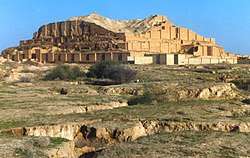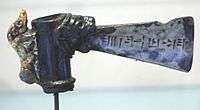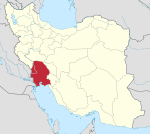Chogha Zanbil
|
چغازنبيل (Persian) Dur Untash (Elamite) | |
 Ziggurat at Chogha Zanbil | |
 Shown within Iran | |
| Location | Khuzestan Province, Iran |
|---|---|
| Coordinates | 32°0′30″N 48°31′15″E / 32.00833°N 48.52083°ECoordinates: 32°0′30″N 48°31′15″E / 32.00833°N 48.52083°E |
| Type | Settlement |
| History | |
| Builder | Untash-Napirisha |
| Founded | 1250 BC |
| Abandoned | 640 BC |
| Cultures | Elamite |
| Site notes | |
| Excavation dates | 1951–1961 |
| Archaeologists | Roman Ghirshman |
| Condition | In ruins |
| UNESCO World Heritage site | |
| Official name | Tchogha Zanbil |
| Criteria | Cultural: (iii), (iv) |
| Reference | 113 |
| Inscription | 1979 (3rd Session) |
Chogha Zanbil (Persian: چغازنبيل; Elamite: Dur Untash) is an ancient Elamite complex in Khuzestan province of Iran. It is one of the few existent ziggurats outside Mesopotamia. It lies approximately 30 km (19 mi) south-east of Susa and 80 km (50 mi) north of Ahvaz.
History and Etymology
The Elamite name of this structure is Ziggurat Dūr Untash,[1] (/ˈzɪɡəræt/ ZIG-ər-at; from the Semitic Akkadian word ziqqurat, based on the D-stem of zaqāru "to build on a raised area"[2]) and Dur Untash is the combination of Elamite Dur (Place/resident/city) like Arabic "Dur/Dar" with the same meaning [3] and Untash the Elamite king who built it. However this structure is known by Its new Persian [4] name today "Chogha Zanbil" that has given to it [5][6] Chogha in Bakhtiari means "hill" . Choga Zanbil means 'basket mound.'[7] It was built about 1250 BC by the king Untash-Napirisha, mainly to honor the great god Inshushinak. Its original name was Dur Untash, which means 'town of Untash', but it is unlikely that many people, besides priests and servants, ever lived there. The complex is protected by three concentric walls which define the main areas of the 'town'. The inner area is wholly taken up with a great ziggurat dedicated to the main god, which was built over an earlier square temple with storage rooms also built by Untash-Napirisha.[8] The middle area holds eleven temples for lesser gods. It is believed that twenty-two temples were originally planned, but the king died before they could be finished, and his successors discontinued the building work. In the outer area are royal palaces, a funerary palace containing five subterranean royal tombs.
Although construction in the city abruptly ended after Untash-Napirisha's death, the site was not abandoned, but continued to be occupied until it was destroyed by the Assyrian king Ashurbanipal in 640 BC. Some scholars speculate, based on the large number of temples and sanctuaries at Chogha Zanbil, that Untash-Napirisha attempted to create a new religious center (possibly intended to replace Susa) which would unite the gods of both highland and lowland Elam at one site.
The ziggurat originally measured 105.2 metres (345 ft) on each side and about 53 metres (174 ft) in height, in five levels, and was crowned with a temple. Mud brick was the basic material of the whole ensemble. The ziggurat was given a facing of baked bricks, a number of which have cuneiform characters giving the names of deities in the Elamite and Akkadian languages. Though the ziggurat now stands only 24.75 metres (81.2 ft) high, less than half its estimated original height, its state of preservation is unsurpassed.
The main building materials in Chogha Zanbil were mud bricks and occasionally baked bricks. The monuments were decorated with glazed baked bricks, gypsum and ornaments of faïence and glass. Ornamenting the most important buildings were thousands of baked bricks bearing inscriptions with Elamite cuneiform characters were all inscribed by hand. Glazed terracotta statues such as bulls and winged griffins guarded the entrances to the ziggurat. Near the temples of Kiririsha and Hishmitik-Ruhuratir, kilns were found that were probably used for the production of baked bricks and decorative materials. It is believed that the ziggurat was built in two stages. It took its multi-layered form in the second phase.
The ziggurat is considered to be the best preserved example of the stepped pyramidal monument by UNESCO.[9] In 1979, Chogha Zanbil became the first Iranian site to be inscribed on the UNESCO World Heritage List.
Archaeology

Choga Zanbil was excavated in six seasons between 1951 and 1961 by Roman Ghirshman.[10][11][12][13][14]
Threats
Petroleum exploration due to increased global demand threatens the foundations of the site, as various seismic tests have been undertaken to explore for reserves of petroleum. Digging for oil has been undertaken as close as 300 metres (984 ft) away from the ziggurat.[15]
See also
- Step pyramid
- Iranian architecture
- List of Iranian castles, citadels, and fortifications
- Cities of the ancient Near East
References
- ↑ Jean Bottéro Ancestor of the West ، Page 88 , In the thirteenth century king Untash Napirisha built Dur Untash "City of Untash" (in modern Persian, Chogha Zanbil)
- ↑ A Dictionary of Ancient Near Eastern Architecture, Page 246: Most ziggurats (the Akkadian word from which the name is derived means "to be high"
- ↑ Right to Passage: Travels Through India, Pakistan and Iran By Zeeshan Khan: page 352: Chogha Zanbil ziggurat is the central instalment, of a city that was originally called Dur Untash after the Elamite king Untash Napirisha, who built a new city here, sometimes in the 13th or 14th century B.C "Dur" means "Place" in Elamite and a Similiraty with the "Arabic" word "Dar"...
- ↑ Jean Bottéro Ancestor of the West ، Page 88 , In the thirteenth century king Untash Napirisha built Dur Untash "City of Untash" (in modern Persian, Chogha Zanbil)
- ↑ Middle East and Africa: International Dictionary of Historic Places By page 186 Trudy Ring : Chogha Zanbil (also spelled Tsoga Zambil) is the "Modern" name for Dur Untash or Al Untash Napirisha, an Elamite city founded in approximately 1250 BC Dur-Untash was the capital city of King Untash-Gal (also known as Untash Napirisha)
- ↑ New Encyclopedia Britannica, page 940, City of Dur Untash ("Modern" Chogha Zanbil).
- ↑ Rohl, D: Legend: The Genesis of Civilisation, page 82. Century, 1998.
- ↑ R. Ghirshman, The Ziggurat of Tchoga-Zanbil, Scientific American, vol. 204, pp. 69–76, 1961
- ↑ "Tchogha Zanbil". UNESCO World Heritage Centre. Retrieved July 15, 2017.
It is the largest ziggurat outside of Mesopotamia and the best preserved of this type of stepped pyramidal monument.
- ↑ Roman Ghirshman, Travaux de la mission archéologique en Susiane en hiver 1952–1953, Syria, T. 30, Fasc. 3/4, pp. 222–233, 1953
- ↑ Roman Ghirshman, Tchoga Zanbil (Dur-Untash). Vol. I: La Ziggurat, Mémoires de la Délégation Archéologique en Iran, vol. 39, Geuthner, 1966
- ↑ R. Ghirshman, Tchoga Zanbil (Dur-Untash) Volume II: Temenos, Temples, Palais, Tombes, Memoires de la Delegation Archeologique en Iran, vol. 40 Geuthner, 1968
- ↑ M.J. Steve, Tchoga Zanbil (Dur-Untash) 3: Textes Élamites et Accadiens, Mémoires de la Délégation Archéologique en Iran, vol. 41, Geuthner, 1967
- ↑ Edith Porada, Tchoga Zanbil (Dur-Untash). Vol. IV (only): La Glyptique, Memoires de la Delegation Archeologique en Iran, vol. 42, Geuthner, 1970
- ↑ Soudabeh Sadigh (November 29, 2006). "Seismographic Tests to be performed on Tchogha Zanbil". Cultural Heritage News Agency. Archived from the original on October 12, 2007. Retrieved September 29, 2009.
Bibliography
- D. T. Potts, The Archaeology of Elam: Formation and Transformation of an Ancient Iranian State, Cambridge University Press, 1999, ISBN 0-521-56496-4
- Roman Ghirshman, La ziggourat de Tchoga-Zanbil (Susiane), Comptes-rendus des séances de l'Académie des Inscriptions et Belles-Lettres, vol. 98 lien Issue 2, pp. 233–238, 1954
- Roman Ghirshman, Campagne de fouilles à Tchoga-Zanbil, près de Suse, Comptes-rendus des séances de l'Académie des Inscriptions et Belles-Lettres, vol. 99, iss. 1, pp. 112–113, 1955
- Roman Ghirshman, Cinquième campagne de fouilles à Tchoga-Zanbil, près Suse, rapport préliminaire (1955–1956), Comptes-rendus des séances de l'Académie des Inscriptions et Belles-Lettres, vol. 100, iss. 3, pp. 335–345, 1956
- Roman Ghirshman, Les fouilles de Tchoga-Zanbil, près de Suse (1956), Comptes-rendus des séances de l'Académie des Inscriptions et Belles-Lettres, vol. 100, iss. 2, pp. 137–138, 1956
- Roman Ghirshman, VIe campagne de fouilles à Tchoga-Zanbil près de Suse (1956–1957), rapport préliminaire, Comptes-rendus des séances de l'Académie des Inscriptions et Belles-Lettres, vol. 101, iss. 3, pp. 231–241, 1957
- Roman Ghirshman, FouiIles de Tchoga-Zanbil près de Suse, complexe de quatre temples, Comptes-rendus des séances de l'Académie des Inscriptions et Belles-Lettres, vol. 103, iss. 1, pp. 74–76, 1959
- Roman Ghirshman, VIIe campagne de fouilles à Tchoga-Zanbil, près de Suse (1958–1959), rapport préliminaire, Comptes-rendus des séances de l'Académie des Inscriptions et Belles-Lettres, vol. 103, iss. 2, pp. 287–297, 1959
- P. Amiet, Marlik et Tchoga Zanbil, Revue d'Assyriologie et d'Archéologie Orientale, vol. 84, no. 1, pp. 44–47, 1990
External links
| Wikimedia Commons has media related to Chogha Zanbil. |


